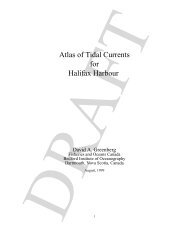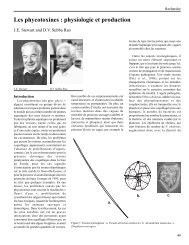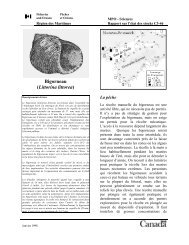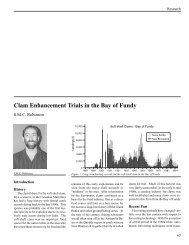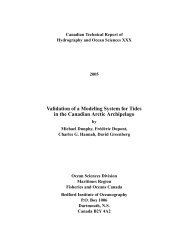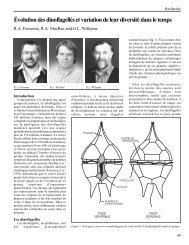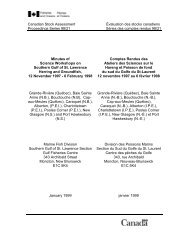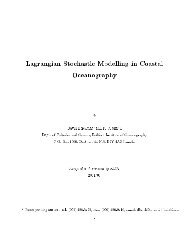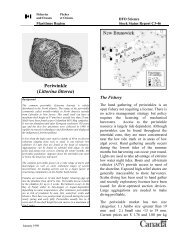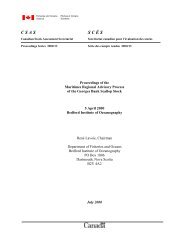CROSS CUTTING ISSUESInteractions between Offshore Oil and Gas Operations andthe Mar<strong>in</strong>e Environment- Peter Cranford, Shelley Armsworthy, Kenneth Lee, Tim Milligan, Kee Muschenheim (Mar<strong>in</strong>eEnvironmental Sciences Division [DFO]), Charles Hannah, John Loder (Ocean Sciences Division [DFO]),Michael Li, Gary Sonnichsen, and Edward K<strong>in</strong>g (Geological Survey <strong>of</strong> Canada – Atlantic [NRCan])Offshore oil and gas operations <strong>of</strong>f the east coast <strong>of</strong> Canada have<strong>in</strong>creased dramatically with<strong>in</strong> the last decade, and are expand<strong>in</strong>g to<strong>in</strong>clude shallow coastal and deep slope waters (Fig. 1). Environmentalfactors such as ice, waves, currents, and seabed structure and stabilitycan greatly affect these activities. Conversely, there is also the potentialthat some oil and gas activities may impact the environment. DFOand NRCan have an ongo<strong>in</strong>g research program, largely supported bythe federal Program for Energy Research and Development, to studythe potential impacts <strong>of</strong> discharges <strong>in</strong>to the environment and environmentalfactors that affect oil and gas activities.Potential environmental impacts associated with the exposure <strong>of</strong>mar<strong>in</strong>e organisms to low-level operational waste discharges are anongo<strong>in</strong>g concern. Drill<strong>in</strong>g wastes (spent drill<strong>in</strong>g mud and well cutt<strong>in</strong>gs)are the primary concern dur<strong>in</strong>g exploration and developmentoperations, while produced water recovered from the hydrocarbonbear<strong>in</strong>g strata is the highest volume waste generated dur<strong>in</strong>g production.Produced water may conta<strong>in</strong> elevated concentrations <strong>of</strong> metals,nutrients, radionucli<strong>des</strong>, hydrocarbons, and trace amounts <strong>of</strong> chemicalagents. A multidiscipl<strong>in</strong>ary research program has been <strong>in</strong>itiated byDFO to study the environmental pathways, transport rate, and ultimatefate and effects <strong>of</strong> drill<strong>in</strong>g and production wastes.Figure 1. Map <strong>of</strong> the eastern Canadian shelf show<strong>in</strong>g areas where licences have been issued for oil and gas explorationand production.36 / BIO-<strong>2001</strong> IN REVIEWFlocculation (the adhesion <strong>of</strong> smaller particles to form large particles)and surface adsorption (the adhesion <strong>of</strong> small particles to largerparticles and/or droplets) are important processes <strong>in</strong> the transport<strong>of</strong> material <strong>in</strong> the ocean. Laboratory studies <strong>of</strong> the behaviour <strong>of</strong> f<strong>in</strong>edrill<strong>in</strong>g waste particles <strong>in</strong> seawater suggest that flocculation couldresult <strong>in</strong> the rapid transport <strong>of</strong> this material to the seafloor. This is <strong>in</strong>contrast to the previous view that these particles settle too slowly toaccumulate to levels that can impact benthic organisms. While dissolvedcontam<strong>in</strong>ants are expected to rapidly dilute with seawater toharmless levels, potential toxic metals <strong>in</strong> produced water wereobserved to transform from dissolved to particulate forms that settledrapidly. Studies also showed that buoyant oil droplets <strong>in</strong> producedwater could sequester particles on their surface. These studies demonstratethe importance <strong>of</strong> aggregation processes that mediate the rapidtransport <strong>of</strong> contam<strong>in</strong>ants to both the surface microlayer and theseabed (Fig. 2). New sampl<strong>in</strong>g methods have been developed at BIOto study waste dispersion around drill<strong>in</strong>g platforms. Application <strong>of</strong>these technologies has revealed that elevated concentrations <strong>of</strong>drill<strong>in</strong>g wastes occasionally exist on and above the seafloor arounddrill<strong>in</strong>g platforms. However, elevated concentrations appear to betransient (days to months) as the wastes are eventually dispersed bycurrents and waves.Given these new <strong>in</strong>sights <strong>in</strong>to the fate <strong>of</strong>waste discharges, laboratory studies arebe<strong>in</strong>g conducted to assess the potentialimpact on selected mar<strong>in</strong>e organisms.Scallops feed on particles <strong>in</strong> an area immediatelyabove the seafloor, the benthicboundary layer, where wastes can accumulate.Exposure to different drill<strong>in</strong>g wastesshowed that important biological effectscan result at waste levels that are lowerthan previously reported for other speciestested. Observed impacts on growth andreproduction were not caused by wastetoxicity, but resulted from f<strong>in</strong>e waste particles<strong>in</strong>terfer<strong>in</strong>g with the animals’ ability t<strong>of</strong>eed. Research is currently <strong>in</strong> progress toassess the utility <strong>of</strong> deploy<strong>in</strong>g caged scallopsaround drill<strong>in</strong>g platforms to verifylaboratory observations and to monitorimpacts at <strong>of</strong>fshore drill<strong>in</strong>g sites.Laboratory biotests with produced waterfrom the Scotian Shelf showed that the tox-
CROSS CUTTING ISSUESFigure 2. Major processes controll<strong>in</strong>g the environmental fate <strong>of</strong> wastes from <strong>of</strong>fshore oil and gas drill<strong>in</strong>g andproduction activities.Figure 3. Multibeam image show<strong>in</strong>g sand ridges and <strong>in</strong>strument deployment transects(white l<strong>in</strong>es) on Sable Island Bank. The black l<strong>in</strong>e is a section <strong>of</strong> gas pipel<strong>in</strong>erunn<strong>in</strong>g through the area.icity <strong>of</strong> produced water was altered as a result <strong>of</strong> chemical changesthat occur follow<strong>in</strong>g its discharge. Toxicity was associated with bothdissolved and particulate fractions. Prelim<strong>in</strong>ary studies suggest thatchemical components with<strong>in</strong> produced water, such as <strong>in</strong>organicnutrients and hydrocarbons, may stimulate the rates <strong>of</strong> primary productionand/or <strong>in</strong>duce changes <strong>in</strong> microbial communities <strong>in</strong> <strong>of</strong>fshorewaters.To determ<strong>in</strong>e the potential trajectories and dispersion <strong>of</strong> operationalwastes at drill<strong>in</strong>g sites, the research program has <strong>in</strong>cluded aquantitative <strong>des</strong>cription <strong>of</strong> the physical environment. Data from currentmoor<strong>in</strong>gs have been used to develop comprehensive threedimensionalcirculation models <strong>of</strong> the eastern Canadian cont<strong>in</strong>entalshelf. A benthic boundary layer transport model was developed to use<strong>in</strong>formation on the currents, the bottom stress, and the settl<strong>in</strong>g velocity<strong>of</strong> the drill<strong>in</strong>g mud to calculate the fate <strong>of</strong>waste discharges. Model predictions have been<strong>in</strong>tegrated with results <strong>of</strong> biological and chemicalstudies to assess the risk <strong>of</strong> environmentalimpacts result<strong>in</strong>g from <strong>of</strong>fshore oil and gasdevelopments. The model has recently beenmodified to <strong>in</strong>clude an improved representation<strong>of</strong> the comb<strong>in</strong>ed effects <strong>of</strong> currents and waveson the fate <strong>of</strong> drill<strong>in</strong>g wastes. We have also<strong>in</strong>cluded a simple model <strong>of</strong> flocculation andbreak-up processes to allow the settl<strong>in</strong>g rate <strong>of</strong>wastes to adjust to local environmental conditions.Evaluations <strong>of</strong> the reliability <strong>of</strong> models areongo<strong>in</strong>g, <strong>in</strong>clud<strong>in</strong>g comparisons with <strong>in</strong>dustryobservations <strong>of</strong> waste distributions.Another important environmental concernfor <strong>of</strong>fshore oil and gas developments is thepresence <strong>of</strong> seabed geohazards. These <strong>in</strong>cludedifficult foundation conditions (for example,weak sediment strata, mass failures, shallow gas,faults, and bouldery till), and geologic processesthat may alter seabed stability (e.g. sediment transport and erosion,and seabed iceberg scour<strong>in</strong>g). Detailed knowledge <strong>of</strong> these seabed stabilityissues and processes is critical to pipel<strong>in</strong>e rout<strong>in</strong>g, drill<strong>in</strong>g siteselection, safe and cost-effective eng<strong>in</strong>eer<strong>in</strong>g <strong>des</strong>igns, and the protection<strong>of</strong> <strong>of</strong>fshore structures and the environment. Geological cor<strong>in</strong>gand sampl<strong>in</strong>g, geophysical and multibeam surveys, sediment transportmeasurements, and model<strong>in</strong>g are all used to identify and assessthe nature <strong>of</strong> seabed <strong>in</strong>stabilities and geologic processes which poseconstra<strong>in</strong>ts to <strong>of</strong>fshore hydrocarbon developments.Cutt<strong>in</strong>g-edge <strong>in</strong>struments (http://agcwww.bio.ns.ca/support/equipment) have been deployed on Sable Island Bank to measure flow<strong>in</strong>tensity, seabed scour<strong>in</strong>g, sediment transport, and mobility <strong>of</strong> smallto medium scale bedforms dur<strong>in</strong>g storms. Instrument deploymentshave been comb<strong>in</strong>ed with repetitive si<strong>des</strong>can and multibeam surveysto understand the morphology, sediment transport processes, andmigration <strong>of</strong> sand ridges (Fig. 3). Geological studies have compiled adetailed database <strong>of</strong> surface and subsurface sediment features onSable Island Bank. Past glacial events and related changes <strong>in</strong> sea-levelhave given rise to a complex suite <strong>of</strong> shallow mar<strong>in</strong>e sand and claybodies. Shallow gas manifests as small pockets or wi<strong>des</strong>pread zones,and tends to be concentrated <strong>in</strong> specific geologic sett<strong>in</strong>gs. Mass sedimentfailure events were found to be rare, except on the outer slope.Iceberg scour research has focused on the northeastern sector <strong>of</strong>Grand Banks. A database <strong>of</strong> almost 6000 scour features (distribution,dimensions, and occurrence frequency) has been compiled. A studywas conducted to document the seabed effects <strong>of</strong> scour<strong>in</strong>g icebergsand to provide <strong>in</strong>sights <strong>in</strong>to the processes and rates <strong>of</strong> scour decay.N<strong>in</strong>e ground<strong>in</strong>g sites were surveyed us<strong>in</strong>g si<strong>des</strong>can sonar, sub-bottompr<strong>of</strong>iler, a remotely operated vehicle, and towed cameras. These surveysprovide case histories for iceberg impacts and form a unique andcomprehensive data set.Research conducted at BIO on these topics and other environmentalfactors, such as sea ice and waves, enhances our ability toaddress environmental issues expressed by clients related to <strong>of</strong>fshoreoil and gas operations. The knowledge obta<strong>in</strong>ed forms the basis forco<strong>des</strong>, standards, regulations, and advice. This knowledge is <strong>des</strong>ignedto reduce costs to <strong>in</strong>dustry while protect<strong>in</strong>g the public, workers, andthe environment from the effects <strong>of</strong> energy related activities.BIO-<strong>2001</strong> IN REVIEW / 37



